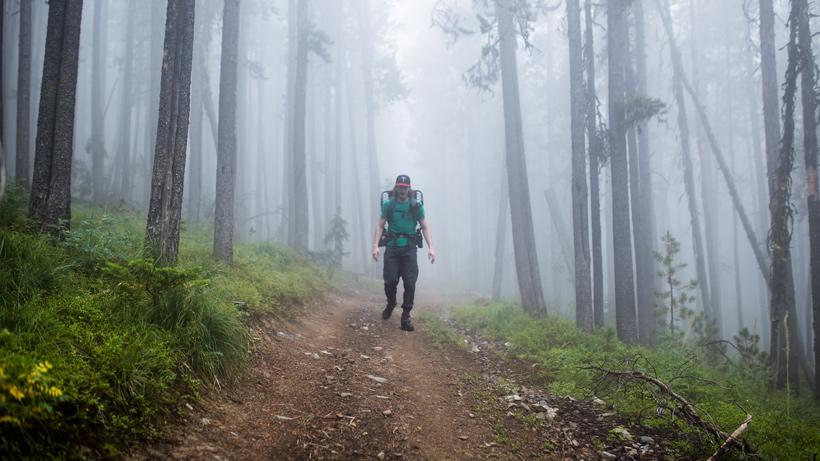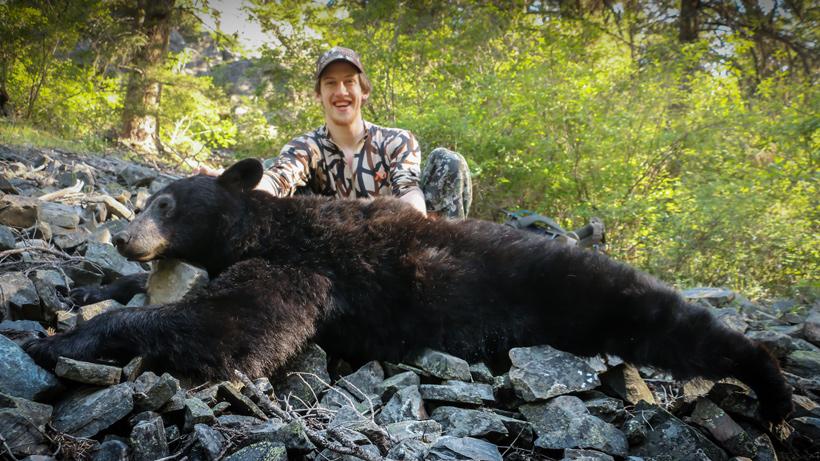




Photo credit: Dan Wilde

Photo credit: Dan Wilde



Google Earth is a great place to begin your scouting for a lot of hunts, but I’ve found that to be especially true with spring bear hunting. Mine is littered with little yellow pins all over western Montana with a simple title: PGS. This stands for “potential glassing spot.”
First, you want to find general areas or mountain ranges that you might be interested in hunting. Then, from there, start picking apart the area, looking for south or east facing slopes. These are the first places for the snow to melt in the spring and, in turn, start growing green grass that bears will likely feed on. Other good pieces of topography to look for are cliffs that have ledges on it and avalanche chutes. Snowpack will be minimal on the cliffs due to the steepness, which means that bears will frequent these ledges, especially early in the season. In steep chutes, an avalanche will clear off a lot of the snowpack and, as Steven Rinella writes in his book on big game hunting, “Locate one of these productive slopes, and you might see multiple bears per day while other hunters are sitting at home because ‘it’s still too early’ to chase bears.” Finding areas with clear cuts and closed logging roads can also be a great place to look. You can walk the logging roads, which often grow grass along the edges and simultaneously glass opposing clear cuts and opening.
Second, now that you’ve found a potential area that might hold bears, you need to find the best vantage point from which to glass them. When hunting steep canyons, you can often find a rocky outcropping or scree slide on the opposing (north-facing) side to post up at. Using the ground level view tool is invaluable here. It will give you a pretty good idea of what you will be able to see from the potential glassing location. You need to take trees and other obstructions into consideration that don’t necessarily show up on Google Earth. Overall, this tool will give you a good idea of whether a spot is worth your time or not. Make sure to mark these areas on your GPS because, when you are hiking in the bottom of the canyon, it’s often so thick that you won’t be able to see these spots from the trail.
Knowing what a bear feeds on in the spring in your area is going to extremely important. I’ve hiked hours back into a spot that looked great from Google Earth, but, once I got there, the slopes that I thought were going to be luscious green grass where actually shrubs or a more undesirable plant like beargrass. It pays to have some knowledge of what these bears are looking for food-wise.
While it’s common knowledge that they love berries in the fall, in my experience, you are going to find them in completely different places in the spring because they are in need of a ripe food source. Where I hunt in western Montana, bears mostly feed on grasses, glacier lilies or skunk cabbage.
Another potential opportunity is to post up on a winter kill. If you find a dead elk, moose or deer in a bear dense area, there is a good chance a bear is going to catch wind of it and come in to claim a free meal. Keep in mind, though, that if you shoot a bear that has been feeding on a rotting carcass for days, the meat is likely going to reflect that. While a bear feeding on green vegetation can taste quite good, one feeding on that kill might not.
This one may only apply to certain hunting areas, but the higher you are willing to hike, the more bears you are going to see. This is due to the simple fact that you are going to be able to see significantly more with each few hundred feet of elevation you gain. Of course, there needs to be a good perch up higher where you can glass from; otherwise, you’re wasting your time or energy.
In the past, I would usually hike 1,000 feet up or so on the opposing ridge. However, after talking with a local bear hunting guide who hunts similar areas that I do, I’m convinced I need to go even higher. In the same canyon where I saw two bears the whole spring, he glassed up eleven in one evening. He was willing to hike thousands of feet up the opposing ridge where he could glass for miles down the canyon.
Granted, if you find a bear that far off, you’re likely not going to be able to get to it that same night if you have to descend thousands of feet first. Regardless, it is going to help you focus in on where exactly the bears are located and, then, you can move in closer the following day.
Now, this tip likely doesn’t apply as much to the steep and deep canyons as it does to the gradual slope areas with closed logging roads. While I prefer to hunt the steep country for bears, areas with closed logging roads and clear cuts can be extremely productive as well. Often, while walking these roads, you will find spots that are absolutely covered in multiple piles of bear scat. If you find a spot like this—with scat that is both fresh and old—you can almost guarantee that a bear will be back. If you can find a spot nearby to watch that area there is a great chance you will glass up a bear. The only problem is that these logging roads are often in such thick areas that it can be hard to find a good place to glass it from.
Lastly, do your best to get comfortable and be patient. Bear hunting can be a lot of hard work, punctuated by a lot of time spent sitting behind your glass with boredom creeping in. When I key in on a great glassing spot, I will sit in the exact spot for an entire day—if not multiple days. It can be tempting to feel like you are being lazy and need to hike, but glassing from a spot where you can see a lot of good country is absolutely going to be the most efficient way to find a bear.
In order to be able to sit that long, do anything you can to make it enjoyable and comfortable. Bring a glassing pad to make those long sits more bearable. Also, mounting your binoculars on a tripod is going to make glassing for extended periods of time extremely more comfortable and help reduce fatigue. Bring snacks, dress warm, and take shifts napping with your hunting buddy. Do anything you can to help yourself be patient enough to stick with it because if you can stay focused and glass good bear country for an extended period of time, you will glass up more bears. And, once you do that, it’s time to make a stalk.